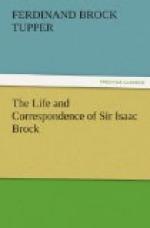[NOTE.—Captain Wool, in stating that he was opposed to four companies of the 49th, only doubled the number of companies; but this exaggeration is a trifle compared with the following gross and hudibrastic mis-statements, relative to the battle of Queenstown in “Ramsay’s History of the United States,” viz: “The 49th British regiment, signalized in Egypt under Colonel, since Lieut.-General, Brock, and usually called the ‘Egyptian Invincibles,’ was among the prominent corps, and was led by its favorite commander. In the second engagement, this regiment of British regulars, 600 strong, encountered a body of 320 American regulars, supported by a few militia and volunteers, the whole under Colonel Chrystie. They mutually resorted to the bayonet, and after a bloody conflict, the famous invincibles yielded to the superior energy of their antagonists, although the latter were so far inferior in numbers. They were rallied by Lieut.-General Brock, who was killed in conducting them a second time to the charge. The American prisoners were kindly treated by this brave regiment, who, after the battle was over, acknowledged they had never opposed more gallant adversaries.”—The 49th, not having been with the British army in Egypt, could not be called the “Egyptian Invincibles;” and instead of this regiment, 600 strong, being led by Major (not Lieutenant) General Brock, only the flank companies were present, with a small body of militia, together about 300 men. In fact, four companies of the 49th were at Kingston, 160 miles distant, and the remaining four battalion companies were, we believe, at Fort Erie, 27 or 28 miles from Queenstown; and therefore, the assertion that the “famous invincibles” yielded to far Inferior numbers, is something worse than ridiculous. Such, however, is the correctness of this American historian on the subject, and with such materials is history too often compiled.—ED.]




